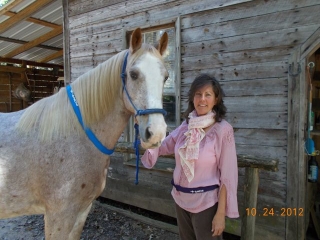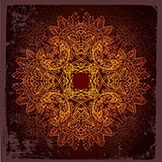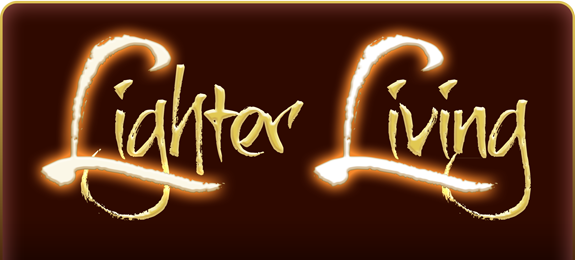EquinEnergetics |
Loved By A Horse

Lisa's eyes are compared to the sun. The similarity is very obvious because the sun is the eye of the day through which perception is made possible. And the eyes in the body, of course, are the muse of every kind of visual perception. Once Lisa, the horse, and their human have linked up, visual perception is used to observe what equines mirror to their humans and vice versa.
A wellness profile is then determined for horse, human, and their environment (shelter, feed, and water), and instructions/education are given on care, benefits, and personalized utilization of the ANCHI Crystal Fields for customer's personal use.
EquinEnergetics
EquinEnergetics Sessions are full~day, on~site sessions. A wellness profile is then determined for horse, human, and their environment (shelter, feed, and water), and instructions/education are given on care, benefits, and personalized utilization of the ANCHI Crystal Fields for customer's personal use.
I come to you, visit your stables and provide online as well as telephone appointments for recommendations!

from the Upanishads - The Sacrificial Horse and the Reversal
aum! uṣᾱ vᾱ aśvasya medhyasya śiraḥ, sῡryas cakṣuḥ, vᾱtaḥ prᾱṇaḥ, vyᾱttam agnir vaisvᾱnaraḥ; saṁvatsara ᾱtmᾱśvasya medhyasya, dyauḥ pṙṣṭham, antarikṣam udaram, pṛthivī pᾱjasyam, diśaḥ pᾱrśve, avᾱntaradiśaḥ pᾱrśavaḥ, ṛtavóṅgᾱni, mᾱsᾱs cᾱrdhamᾱsᾱś ca parvᾱṇi, ahorᾱtrᾱṇi pratiṣṭhᾱḥ, nakṣatrᾱny asthīni, nabho mᾱṁsᾱni; ῡvadhyaṁ sikatᾱḥ, sindhavo gudᾱḥ, yakṛc ca klomᾱnaś ca parvatᾱḥ, oṣadhayaś ca vanaspatayaś ca lomᾱni, udyan pῡrvᾱrdhaḥ nimlocañ jaghanᾱrdhaḥ, yad vijṛmbhate tad vidyotate, yad vidhῡnute tat stanayati, yan mehati tad varṣati; vᾱg evᾱsya vᾱk.
This is the first Mantra which is written in prose, the style of the Brᾱhmaṇa portion of the Vedas. Uṣᾱ vᾱ aśvasya medhyasya śiraḥ: The dawn is the head of this sacred horse. The idea is that every part of the essential item in the sacrifice is to be identified, correspondingly, part by part, with the sections of the universe outside. In worship, especially that performed in temples, we have also a similar technique adopted, which is known as the Nyᾱsa method – the placement. Nyᾱsa means placement. The parts of the body of the worshipper are correspondingly placed in the parts of the body of the deity, so that the distinction between the worshipper and the deity is abolished. The two become one. Such a Nyᾱsa is done here. The head of the sacrificial horse must be contemplated as the dawn. Here, the dawn does not necessarily mean a particular time of the eve of the rise of the sun at any particular place, but the eastern part, mostly conceivable by the mind, as the world, as it can be visualised by us to the extent possible. Now, if it is not possible to conceive it in this manner, it can be taken literally as the eastern part of the world where we are living. The dawn is the head of the consecrated horse. The dawn, the beginning of the day, is the head, because the head is the beginning of the body. That is the similarity. The day begins with the dawn, and the body begins with the head. This is the similarity conceived here.
The eyes may be compared to the sun. The similarity is very obvious, because the sun is the eye of the day through which perception is made possible; and the eyes, of course, in the body, are the means of every kind of visual perception.
The Cosmic Wind, the Air that pervades, is the Prāṇa within. We should identify the Prāṇa within the horse with the Air that is outside, because the two are essentially the same, one working in the world outside and another working within the body of the individual, here, the horse.
The mouth is the Agnī Vaiśvᾱnara. In some Upaniṣhads, the Aitareya particularly, we have another cosmological description where we are told that from the Cosmic Virāt, Fire broke out through the mouth. And the organ of speech is supposed to be presided over, in every case, by the principle of Fire. So the mouth of the individual horse, here, may be identified with the cosmic fire which is Vaiśvᾱnara. Vaiśvᾱnara is a word which has two or three meanings. It is a fire principle which is hiddenly present in all things, the principle of fire which manifests itself as the visible fire outside, which, again, is sometimes identified with the Cosmic Being. Vaiśva-Nara means the Cosmic-Man, and the derivative of this word is Vaiśvᾱnara. The Vaiśvᾱnara is the Cosmic Person who represents the energy of all things, manifested outwardly as the fire principle, energy secondarily manifest, again, as the power of speech. And so, the mouth is to be identified with the Vaiśvᾱnara, the principle of Divine Fire.
The body is the entire process of the year. The Time process is the body, because the body has many limbs, many parts; and likewise, time can be segmented into parts – past, present, future; and if it is concretised further, it becomes capable of division into years, months, days, nights, etc. The comparison is that, as the time has divisible parts, so the body also has divisible parts. The two are identified.
The Sky is the back, as it were. The comparison is that it is on the top, above the body.
The Atmosphere is the belly, because it is hollow, as it were.
The Earth is the hoofs, on which the animal is placed.
The sides are the quarters of the heavens.
The sides of the body, consisting of the bones, may be compared to the intermediary quarters, which are between the main quarters.
The seasons are the limbs of the body. Even as the Saṁvatsara, or the year, is constituted of various seasons, the body is constituted of various limbs.
The divisions of the year, namely the month, the half-month, the bright half and the dark half of the month, etc., are the parts of the entire physical body, just as the year may be supposed to be placed on the parts consisting of the months, days, etc.
The day and night are the essence of the calculation of Time, and, therefore, the year may be supposed to be rooted in the calculation or conception of day and night. Thus is also the body rooted, or placed, or supported by the feet. So, the day and night are said to be the feet of the horse.
The constellations in the sky may be compared to the whitish bones which are spread out, as it were, in all parts of the body.
The clouds are the flesh of the whole body.
The sand that you can see anywhere, physically, in the world, may be compared to the half-digested food that is in a seed condition in the stomach.
The rivers are the veins and the arteries.
The spleen and the liver are the mountains, as it were, which are something like an elevation in the body within.
The trees and the plants and the shrubs may be compared to the hairs of the body.
The sun, rising, is the earlier, fore part of the body.
The hind part of the body may be compared to the sun that is about to set.
The horse's yawning is something like the lightening.
The shaking of the members of the body is like the thunder in the rainy season.
Its making water is like the rainfall.
The sound that it makes, neighing, is the principle of speech.
This description of the Cosmos as Horse is entirely symbolic, and highly complicated to conceive, because the purpose of the Upaniṣhad is to bring out the psychological element that is present in the comparison that is made between the physical counterparts of the body of the horse, and the body of the universe outside. The difference between the horse conceived here, or to make a wider comparison, the case of any individual, for the matter of that, the distinction between the body of an individual, whether of an animal or a human being, and the world outside, is psychological. If it were not psychological and is really physical, an identification would be impossible. That one person is different from another person, is a psychological division. It is not physical. We have had occasion to discuss this subject earlier in some of our discourses.
I shall give you a small example of how physical division does not exist. It is only imaginary. The bodies of people are constituted of the five elements – earth, water, fire, air and ether. Your body, my body and everybody's body is constituted of only these things, nothing else – earth, water, fire, air, ether. If the body of one individual, 'A', is substantially the same as the body of another individual, 'B', because of its being formed of the same five elements, what is the reason for the distinction or the difference that we make between one body and another body? It is that which exists between the two bodies. The space is the cause. But space is a part of the very constitution of the body itself. So, how does this become an element of distinction? That which we regard as spatial, and, perhaps, the only reason for the distinction that we usually make between one body and another, is an element essentially present in the constitution of the body itself. So to say that space is the distinctive mark of division between one body and another is logically not tenable. It is a peculiar thinking of the minds of people that makes it impossible for them to feel the coextensive nature of bodies, as if they are connected at the bottom, like the waters of the ocean. Inasmuch as physical distinctions are not tenable ultimately, the distinctions are to be regarded as purely mental, or psychological; and therefore, a mental act can abolish the mental distinction that has been thus created.
The entire psychology of meditation is nothing but a setting right of errors in thought; and the details of these methods we shall be considering as we proceed further. So, to come to the point, this distinction between the individual unit and the Universal Substance is to be abolished for the purpose of the removal of the sorrow of the individual. Meditation is the technique of the removal of sorrow in the sense that sorrow is caused by the segregation of the individual from the world outside. For this purpose, one enters into the technique of meditation. Now, here, the context being sacrifice, we are given a method which is ritualistic in its nature, and thus the ritualistic horse of the Aśvamedha Sacrifice becomes an object of contemplation, literally, liturgically as an animal in the sacrifice, but psychologically and spiritually, as an element like any other element in creation as a whole. The subject is continued in the next Mantra.
ahar vᾱ aśvam purastᾱn mahimᾱ nvajᾱyata. tasya pῡrve samudre yoniḥ, rᾱtrir enam paścᾱn mahimᾱ nvajᾱyata, tasyᾱpare samudre yoniḥ, etau vᾱ aśvam mahimᾱnᾱv abhitaḥ sambabhῡvatuḥ hayo bhῡtvᾱ devᾱn avahat, vᾱjī gandharvᾱn, arvᾱsurᾱn, aśvo manuṣyᾱn; samudra evᾱsya bandhuḥ, samudro yoniḥ.
Again, this is a ritualistic peculiarity of the Brᾱhmaṇa, concerned with the Aśvamedha Sacrifice. Mahimā is a term used to designate certain sacrificial vessels, gold and silver, placed in the performance of the sacrifice. The daytime may be compared, says the Upaniṣhad, to the golden cup that is placed in the front of the horse.
The eastern ocean, by which what is intended is the farthest eastern limit of the conceivable world, is the base. The world ends with the ocean. That is how we have to think, because we cannot think more than that. What can a child think? If you ask a baby to think of the world, it will think only up to the ocean. Beyond that, no thought is possible. But this is only a beginning of the method of extending the thought to further and further limits, until we reach the limit of the psychological horizon. The idea is that the eastern ocean is to be regarded as the limit, the farthest possible for the mind in contemplating the horizon of the universe. That is the limit of the horse.
Similarly, the rear part may be compared to the night, and the western ocean, which is the other side of conceivable limit. Thus, the horse is enveloped, encircled by the ritualistic elements, which means to say, in this process of contemplation, the parts of the world are contemplated as associated with the world which is, here, the object of contemplation. Just as the parts in a sacrifice are associated with the element in the sacrifice which is the horse, the parts of the world or the universe are to be conceived as associated with it as parts are associated with the whole.
Here is a very difficult passage whose meaning is very obscure. But evidently what its meaning is, is this, that there is a gradual ascent and descent of the degree in the concept of the horse, or rather, the concept of the universe. When you think of the universe as an object of contemplation, you think of it in various degrees – the gross, the subtle and the causal. And the commentators, especially Achārya Śankara, and others, tell us that the horse mentioned here is the Prajāpati, or the Creator of the cosmos. It is not merely the animal in the sacrifice. That is how we have to think in meditation. So, as there is a descent from the causal condition to the subtle condition, and from the subtle to the gross, and from the gross to the variegated forms of manifestation in this world, so also is the horse to be contemplated in the various aspects of its functions, and the functions are mentioned here in respect of the ritual of the Aśvamedha Sacrifice.
When the horse becomes the vehicle of the celestials, it is called 'Hayo'. When it becomes the vehicle of Gandharvas, demi-gods, above the earth, it is called 'Vājī', a peculiar name ascribed to the horse. When it becomes the vehicle of the demons, it becomes 'Arva'. It becomes the ordinary horse, Aśva, when it becomes the vehicle of human beings. The substance of all these things is the ocean. Here, the great commentator, Achārya Śankara tells us the ocean means the Cosmic Soul. It does not mean the ocean which is water. The Universal Soul is the basis of the world, as the horse is the basis of the entire sacrifice. It is the substratum; and every activity – name, form, action – is something like a wave in the ocean. But the wave is the ocean. The wave is in the ocean, or on the ocean, as you may think of it. Likewise, all actions, name and form, rise and subside within the bosom of the universal Soul, so that you may say, just as waves are the ocean, actions are the Universal Soul. So the universe is the ocean, or rather, the Universal Soul is the ocean. That is the deepest and the nearest associate. The greatest friend of man is God. That is what is intended here. And He is the support, ultimate resort and refuge – samudra evᾱsya bandhuḥ, samudro yoniḥ.
Contact Lisa: lkkretschmer@gmail.com


